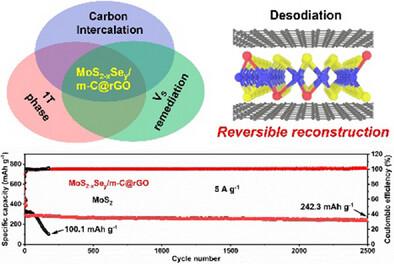氧掺杂碳单层嵌入和硒化稳定富t二硫化钼以实现快速和持久的钠离子储存
IF 26
1区 材料科学
Q1 CHEMISTRY, PHYSICAL
引用次数: 0
摘要
金属1T-MoS2具有优异的导电性、丰富的活性位点和对Na+的低吸附障碍,是一种很有前途的钠离子电池阳极材料。不幸的是,固有的亚稳特性和缺陷导致的结构稳定性差给循环寿命带来了无与伦比的挑战。本文提出了一种碳嵌入和硒化的协同策略,以构建稳定的富含1t的MoS2-xSey,并通过还原氧化石墨烯(MoS2-xSey/m-C@rGO)上的C─S/Se和C─O─Mo键与嵌入的碳单层共价结合。异质结构扩大了Na+快速扩散的层间距离,提供了稳定层状结构的有限原子厚度间距,诱导了1T相的形成,并促进了碳单分子层向S原子的电荷转移。硒化修复了硫空位,同时由于诱导晶格应变和电子结构调制而使1T相稳定。因此,在5ag−1下,电极在2500次循环后提供242.3 mAh g−1的容量,相对于5ag−1下的初始容量,容量保持率为82.6%。在183 W kg - 1时,完整的电池提供了167.7 Wh kg - 1的吸引人的能量输出。提出了可逆重构的原子水平机理。这项工作为sib中耐用、高速率电极的设计提供了有价值的见解。本文章由计算机程序翻译,如有差异,请以英文原文为准。

Oxygen-Doped Carbon Monolayer Intercalation and Selenization Stabilizing 1T-Rich MoS2 to Enable Fast and Durable Sodium-Ion Storage
Metallic 1T-MoS2 is a promising anode for sodium-ion batteries (SIBs) due to its excellent conductivity, abundant active sites, and low adsorption barrier for Na+. Unfortunately, intrinsic metastable features and defect-caused poor structure stability pose an unparalleled challenge in cycle life. Herein, a synergetic strategy of carbon intercalation and selenization is proposed to construct stable 1T-rich MoS2-xSey, which is covalently bonded to intercalated carbon monolayers via C─S/Se and C─O─Mo bonds on reduced graphene oxide (MoS2-xSey/m-C@rGO). The heterostructure expands the interlayer distance for fast Na+ diffusion, provides confined atomic-thickness spacing stabilizing the layered structure, induces the formation of the 1T phase, and promotes charge transfer from carbon monolayers to S atoms. Selenization remediates sulfur vacancies while enabling the stabilization of the 1T phase due to induced lattice strains and electronic structure modulation. Consequently, the electrode delivers a capacity of 242.3 mAh g−1 after 2500 cycles at 5 A g−1, corresponding to a capacity retention of 82.6% relative to the initial capacity at 5 A g−1. The full cell delivers an appealing energy output of 167.7 Wh kg−1 at 183 W kg−1. An atomic-level mechanism of reversible reconstruction is proposed. This work provides valuable insights toward the design of durable, high-rate electrodes in SIBs.
求助全文
通过发布文献求助,成功后即可免费获取论文全文。
去求助
来源期刊

Advanced Energy Materials
CHEMISTRY, PHYSICAL-ENERGY & FUELS
CiteScore
41.90
自引率
4.00%
发文量
889
审稿时长
1.4 months
期刊介绍:
Established in 2011, Advanced Energy Materials is an international, interdisciplinary, English-language journal that focuses on materials used in energy harvesting, conversion, and storage. It is regarded as a top-quality journal alongside Advanced Materials, Advanced Functional Materials, and Small.
With a 2022 Impact Factor of 27.8, Advanced Energy Materials is considered a prime source for the best energy-related research. The journal covers a wide range of topics in energy-related research, including organic and inorganic photovoltaics, batteries and supercapacitors, fuel cells, hydrogen generation and storage, thermoelectrics, water splitting and photocatalysis, solar fuels and thermosolar power, magnetocalorics, and piezoelectronics.
The readership of Advanced Energy Materials includes materials scientists, chemists, physicists, and engineers in both academia and industry. The journal is indexed in various databases and collections, such as Advanced Technologies & Aerospace Database, FIZ Karlsruhe, INSPEC (IET), Science Citation Index Expanded, Technology Collection, and Web of Science, among others.
 求助内容:
求助内容: 应助结果提醒方式:
应助结果提醒方式:


